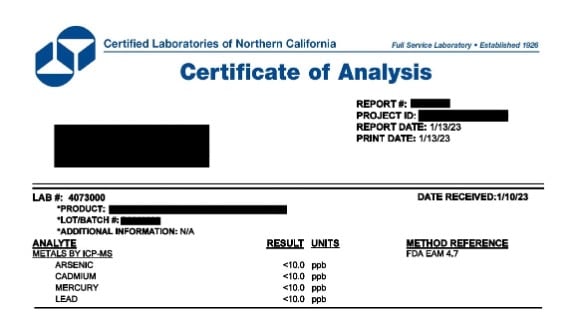Heavy metals in food always seems to be a hot topic. First it was concern over heavy metals in baby food. Not long ago, news broke about lead and cadmium in some brands of dark chocolate.
Whatever food product, dietary supplement, cosmetic, spice, or similar product you produce, heavy metals testing is important, but often poorly understood. In this post, we explain how to test for heavy metals in food and other products. We’ll also explain how to test for lead in food. Let’s get started.
How Does Heavy Metal Get into Food?
Nearly everyone knows that heavy metals such as lead, cadmium, arsenic, and mercury originate from pollution. Many of us remember leaded gasoline before it was fully banned in the United States in 1996, or leaded paint before it was banned in 1978.
But many people are surprised to learn that heavy metals occur naturally in the environment and are present in some foods.
Plants can absorb heavy metals from the ground, air, or water, contaminating the food supply. That means an animal or human that eats such a plant can ingest heavy metals.

Because heavy metals are a natural part of the environment, and due to decades of pollution, it can be extremely difficult to eliminate them completely, if not impossible. As such, we must be diligent about protecting the food supply, which includes testing for heavy metals in foods and other products before they reach the public.
What are the 4 Most Toxic Heavy Metals?
Although any heavy metal can be toxic if consumed excessively over long periods of time, these four heavy metals are particularly toxic to humans and draw the most scrutiny:
- Lead
- Cadmium
- Mercury
- Arsenic
These metals are especially toxic to children due to the neurological effects they can have during development.
Chronic exposure to anyone, not just children, can lead to a host of health problems, including cancer, anemia, brain damage, kidney failure, and other problems. That being the case, the FDA says it monitors these four heavy metals in food and other products most closely.

What is Acceptable Heavy Metal Content in Food?
Here is where the entire issue of heavy metals in food and other products becomes hazy.
While it is common knowledge that excessive consumption has serious consequences, the U.S. FDA does not mandate acceptable limits for heavy metals in food.
Instead, the FDA has historically provided advice to consumers about eating certain foods susceptible to heavy metals, such as seafood and rice-based baby food. FDA has also proposed levels to industry for reducing arsenic in some foods often eaten by children and infants, such as apple juice.
But, if you are looking for a single resource that shows the FDA’s acceptable levels of lead, cadmium, mercury, or arsenic in the food products you produce, you will not find it because it does not exist.
How Does the FDA Monitor Heavy Metals in Food?
Rather than establish heavy metal limits for every food product, the FDA monitors the nation’s food supply through its Total Diet Study. The agency samples hundreds of foods from across the country and tests them for more than 400 contaminants, including heavy metals. The agency uses that data, and additional data it acquires, to understand the typical American’s diet, helping ensure safety.
Despite a lack of published limits, FDA can detain imported products due to elevated heavy metals content. The agency then determines through testing if the product is safe for entry into U.S. commerce based on its own criteria.

The FDA monitors heavy metals in the food supply through its Total Diet Study, which seeks to understand the typical American’s diet to help ensure safety.
California Prop 65 Sets Limits for Some Heavy Metals
While there are no Federal limits for heavy metals in foods, the state of California does set some limits in its Proposition 65 legislation.
In fact, Consumer Reports used California's maximum allowable dose level of lead (0.5 micrograms) and cadmium (4.1 micrograms) when they conducted their dark chocolate test for lead and cadmium.
Results showed that 23 of the 28 dark chocolates tested contained lead or cadmium in excess of those levels.
So, what is acceptable heavy metal content in food? It depends on who you ask. California officials set limits in Prop 65, but the FDA does not establish federal limits. However, the FDA does provide guidance for some foods, such as apple juice and rice-based baby food.
The lack of clear regulations makes your job as a Quality Control professional even more difficult. When in doubt, it helps to reach out to regulatory experts, like those at EAS Consulting Group, a Certified Group company, for guidance.
Do I Need to Test for Heavy Metals in Food?
Given the lack of Federal regulations, you may wonder if your company even needs to test for heavy metals in your food products or other products.
As frustrating as it can be, the answer is, “It depends”.
Your company should start with developing a strong food safety management system that includes a robust hazard analysis and risk assessment for the ingredients as well as the manufacturing process. If the risk for specific heavy metals or other California Prop 65 contaminates, specifically in the ingredients, is great enough, then testing may be warranted as a verification tool.
It is important to note that while an ingredient may not have high risk of heavy metals or other contaminates, the process may increase that risk. For example, nuts may not be of concern but, when roasted, the process may introduce a contaminate called “acrylamide” for which you want to test.
How to Test for Heavy Metals in Food
As said earlier, testing for heavy metals in food is one of the most common analytical chemistry tests we perform at Certified Laboratories. Not only do we run the test on food products, but we also test for heavy metals in dietary supplements, cosmetics, spices, and other products. The same fundamental steps apply regardless of which product is being tested, although the precise methodology may change slightly.
Let’s look at how the heavy metals test is done starting at the beginning when the customer obtains a sample. We will use the example of dark chocolate, for which we use the industry standard FDA EAM 4.7 methodology.
Step 1: Obtain a Sample
The process begins with the manufacturer at the facility. You need not do anything special to obtain the sample you send to the laboratory; it can be a finished product right off the shelf or assembly line.
When testing an entire lot, however, be sure to generate random samples. Rather than pull the first 50 grams of product off the line, for example, pull samples randomly from the entire product lot. Package the samples and send them to our laboratory. If the product requires refrigeration, send the samples in the appropriate packaging to preserve integrity.
Step 2: Sample Preparation
Upon receipt, we prepare and homogenize the samples to ensure a representative sample of the entire lot is tested.
In the case of dark chocolate, we blend all samples submitted to form a single mixture that will ensure any portion removed for testing has the same characteristics as any other.
Step 3: Digest the Sample
To digest the sample, we place about ½ gram of dry mass into a digestion vessel, which looks essentially like a Teflon tube. Nitric acid, hydrochloric acid, and hydrogen peroxide are added to break down the dark chocolate or other product into its constituent parts.
This mixture is placed into a microwave that operates at a higher wattage than your typical kitchen microwave to rapidly increase the temperature of the sample to 200°C. The acids combined with the heat breaks down the product into a clear liquid.
Step 4: Test Using ICP-MS
The clear liquid produced after digestion is diluted with water. The resulting mixture is set up in an Inductively Coupled Plasma Mass Spectrometry (ICP-MS) instrument that analyzes it for common isotopes of lead, cadmium, mercury, arsenic, and any other heavy metal the customer specifies. To test for lead in food, we analyze for isotopes 206, 207, and 208.
Step 5: Provide a Certificate of Analysis
Finally, we calculate the concentration of heavy metals in the food or other product based on the starting mass. The information is reported as parts per billion on a Certificate of Analysis (COA) provided to the customer. That is how to test for heavy metals in food and other products.
It’s important to note that your COA will not indicate if your products passed or failed the test; it’s up to your company to determine pass/fail criteria based on the regulations that apply to your products or your own company goals.
This simple example for heavy metal testing shows what to expect when you receive a COA from Certified Laboratories. The heavy metals tested for are shown, along with the results in parts per billion and the test methodology. In this case, all four heavy metals tested at less than 10 ppb.

Why Choose Certified Group for Heavy Metals Testing in Food?
Heavy metals testing is a critical part of your food safety process. It’s an excellent tool earlier in the product development process as well to help screen raw materials for issues prior to formulation.
Certified Laboratories and Food Safety Net Services (FSNS), both Certified Group companies, provide heavy metals testing for food, supplements, hemp products, spices, cosmetics, and other products at our nationwide network of accredited laboratories. We use validated methodologies and provide results quickly.
- Fast turnaround time
- ISO 17025 accredited labs
- Validated methodologies
- 24/7 access to your Certificate of Analysis
- Responsive service
- Regulatory consulting
Complete the form below to ask a question or get a quote for your heavy metals testing.
